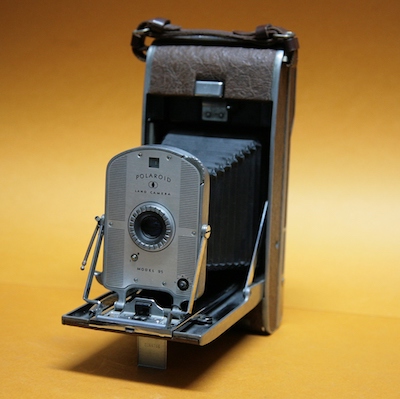Summary | Excerpt | Reading Guide | Reviews | Beyond the Book | Read-Alikes | Genres & Themes | Author Bio

A novel
by Valeria LuiselliThis article relates to Lost Children Archive
 Once upon a time, long before digital photography became commonplace, the only way to instantly see the results after taking a photo was by using a Polaroid instant camera. In Lost Children Archive, the narrator gives her stepson a Polaroid camera for his tenth birthday. He takes photos during their trip, and a series of Polaroid images is included in the novel itself.
Once upon a time, long before digital photography became commonplace, the only way to instantly see the results after taking a photo was by using a Polaroid instant camera. In Lost Children Archive, the narrator gives her stepson a Polaroid camera for his tenth birthday. He takes photos during their trip, and a series of Polaroid images is included in the novel itself.
Edwin Land – one of the co-founders of Polaroid in 1937 – was an avid inventor who experimented with varieties of photography. Fascinated by light, optics, and the possibilities of color imagery, he pioneered many inventions and would eventually hold more than 500 patents. The Polaroid Land Camera, the first instant camera, launched in 1948. It relied on special chemically-coated film layers which were pressed through a roller as soon as the photographer took the shot. The film took about a minute to develop, and when the top layer was peeled away, a sepia-toned image remained.
The results weren't always reliable due to variations in temperature, unexpected exposure to light, or limitations inherent to the lens. Unlike traditional film photography, which allows multiple prints from one negative, each Polaroid instant image is unique. These early-generation instant cameras were cumbersome and relied on rolled film and a bellows to protect developing images from light. At one point, Ansel Adams was hired as a consultant, and the company eventually developed large format instant cameras and camera backs for professional use. Before the days of digital photography, many professionals used a Polaroid back on their SLR or view cameras to get instant feedback about their model or scene.
 Over the years, the instant camera was modified, and new types of film were invented to make the user experience easier and more fun. By 1962, Polaroid had expanded production to Japan and manufactured more than 4 million instant cameras. Some models were given popular names like "The Swinger" (1965), "The Countdown" (1970), "Big Shot" (1971), "Super Shooter" (1975), "One Step" (1977), "Pronto!" (1978) and even a "Barbie Instant Camera" (1999). The SX-70 launched in 1972 and continued to innovate with auto-focus and reliability. By this time, Polaroid film was available in color and was purchased in flat unit packs. The photographer would load the entire pack and shoot down until the pack was emptied (ten shots). Each photo sheet was pressed when the camera "zoomed" out and would develop during the next few minutes. The SX-70 was popularized by photographers and artists like Andy Warhol who wanted to push the boundaries of traditional darkroom techniques or have fun snapping candids of their friends.
Over the years, the instant camera was modified, and new types of film were invented to make the user experience easier and more fun. By 1962, Polaroid had expanded production to Japan and manufactured more than 4 million instant cameras. Some models were given popular names like "The Swinger" (1965), "The Countdown" (1970), "Big Shot" (1971), "Super Shooter" (1975), "One Step" (1977), "Pronto!" (1978) and even a "Barbie Instant Camera" (1999). The SX-70 launched in 1972 and continued to innovate with auto-focus and reliability. By this time, Polaroid film was available in color and was purchased in flat unit packs. The photographer would load the entire pack and shoot down until the pack was emptied (ten shots). Each photo sheet was pressed when the camera "zoomed" out and would develop during the next few minutes. The SX-70 was popularized by photographers and artists like Andy Warhol who wanted to push the boundaries of traditional darkroom techniques or have fun snapping candids of their friends.
By 2009, with the rise of digital photography, Polaroid discontinued production of instant film. Enter the Impossible Project, brain-child of a Dutch team who re-built the film technology after the last Polaroid factory closed. Impossible then morphed into a new company, Polaroid Originals, in 2017. Polaroid Originals now offers new retro-styled cameras like the OneStep2, along with refurbished, vintage Polaroid cameras. They also manufacture instant film for fans who want to keep the spirit of unique and instant print photography alive in the digital age. If anyone has an old SX-70 in your storage box, you can once again source film to document your own road trip. A long-anticipated exhibit, The Polaroid Project: At the Intersection of Art and Technology, opened at the MIT Museum in Cambridge, Massachusetts in Fall 2019 and will remain open until June 2020 (with a brief hiatus from February 24-March 8). Photographs and equipment will showcase the versatility and endurance of the Polaroid instant camera over the decades.
Polaroid Model 95, the company's first instant camera introduced in 1948
Polaroid SX-70
Filed under Music and the Arts
![]() This "beyond the book article" relates to Lost Children Archive. It originally ran in February 2019 and has been updated for the
February 2020 paperback edition.
Go to magazine.
This "beyond the book article" relates to Lost Children Archive. It originally ran in February 2019 and has been updated for the
February 2020 paperback edition.
Go to magazine.
The worth of a book is to be measured by what you can carry away from it.
Click Here to find out who said this, as well as discovering other famous literary quotes!
Your guide toexceptional books
BookBrowse seeks out and recommends the best in contemporary fiction and nonfiction—books that not only engage and entertain but also deepen our understanding of ourselves and the world around us.